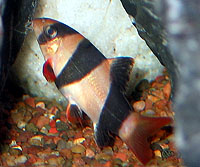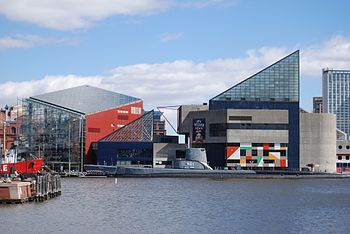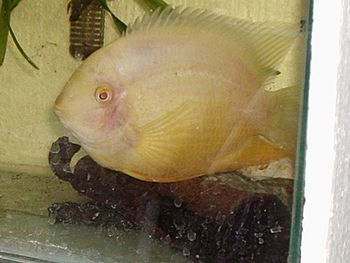 |
A clown loach (Photo credit: Wikipedia)
|
A barbel is a slender, whisker-like tactile organ. Maxillary refers to the barbel's location near the mouth. These tentacle-like organs houses taste buds and are used to search for food in murky water. Barbels are a bottom-dwelling species of scavenger fish like catfish and carp. Barbles and downward pointed mouth are what distinguish bottom dweller from other fish. The clown loach is one such bottom dweller.
Bottom dwellers, in general, make a good addition to any community fish tank. The scavenging of food from the aquarium substrate helps prevent harmful chemical build up in the water. Most bottom dwellers are peaceful fish that tend to keep to themselves. They don't concern themselves with what is going in the water above them.
The clown loaches you see for sale in fish stores are very young. They look so cute it is tempting to buy one and take them home. Make no mistake. This species is among the largest freshwater varieties available commercially. They can grow up to 16 inches long as adults. Take this into consideration before deciding to purchase one.
An interesting behavioral note: Clown loaches have a peculiar tendency to spend a lot of time lying on their sides. Don't be alarmed. They are not sick or injured. This is just their normal behavior.
This fish's native water habitat is neutral water (pH of 7.0) with a water temperature between 75-86 degrees Fahrenheit. Clown loaches are intolerant of poor water conditions. They are prone to develop ich if left in unsatisfactory living conditions for extended periods of time.
Like all scavenger fish, clown loaches are omnivores. They can generally scavenge enough food that has been missed by the fish above them to survive just fine. But food that sinks, such as sinking wafers will ensure they have more than enough nourishment to survive.
Clown loaches are egg layers. They are not known to breed in captivity. Attempts to do so have been mostly unsuccessful. There are a few instances where clown loaches have been reported to spawn in captivity. But this is a rare occurrence.
The clown loaches are aware enough of their surroundings to realize they have been removed from their natural habitat. As a result, they have higher stress levels than much other fish. A good way to help reduce their stress levels is by providing them with plenty of hiding spaces on the bottom of your tanks such as rocks and plants. Once they adapt to their new surroundings they will be just fine.
Clown loaches are a long-lived species given proper living conditions. It is not uncommon for them to live from 40 to 50 years of age. It takes them years just to reach sexual maturity.
Many home aquarium owners cringe at the thought of maintaining a saltwater aquarium. What most of them don't realize is that a Jellyfish Fish Tank Aquarium requires little more maintenance than a freshwater tank. Keeping Pet Moon Jellyfish is the hottest new trend in aquarium ownership. Article Source: EzineArticles |






